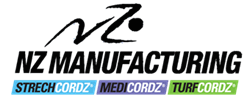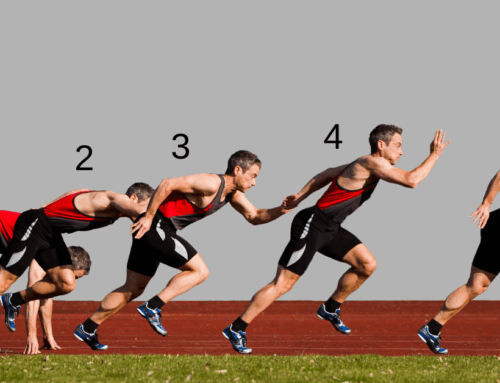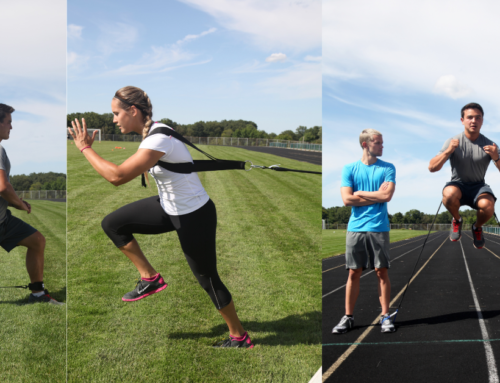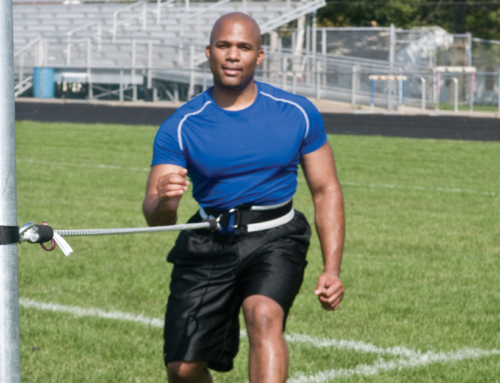The rate of force development, commonly called power, is crucial to many sport performances. Running athletes develop power by generating the maximum amount of force over the shortest period of time. The product of stride length (force applied) and stride frequency (motion) will determine running speed. To optimize performance in running it takes mobility and strength. One of the best ways to increase mobility and strength to specifically carry over to running is to use elastic resistance training.
The training principle of specificity requires that you use your muscles in the same contraction mode and range of motion in training that you are interested in improving for your skill. Using elastic resistance like the TurfCordz series can help a runner develop functional strength that will carry over to increasing running performance. The properties of elasticity allow for resistance patterns that are independent of gravity but dependent upon rate and length of stretch of the cord. In addition, Cords have the advantage of applying resistance in multiple planes of unrestrained movement patterns. When athletes engage in varied speed drills the resistance also accommodates so muscles can work in the same movement pattern and joint angles specific to running. This accommodative property occurs with both slow speed and high speed training. The cord can be used for explosive start drills, or even with performing isometric holds in positions when the band is stretched; for example lunge positions) . Ultimately the resistance can be tailored specifically to the area of strength weakness the runner may need to improve.
Running uses a considerable amount of abdominal strength. To strengthen the abdominals and rotator muscles of the trunk cord resistance can be used to offset excessive twisting that can occur due to muscle weakness and prevent the hips and shoulders from rotating too much during the run. It is very difficult, if not impossible; to duplicate the exact movements of the legs, hips, and shoulders used in running with isotonic loads using dumbbells, barbells, or machines.
Furthermore, the low inertia of the cord mass makes high speed training a real plus with this type of equipment. Muscles store energy when undergoing lengthening just like elastic cords. This type of training is very portable and is not limited to a gym/fitness setting which makes it ideal for runners who want to take the cords to the track. Runners can also partner with other runners and match resistances by alternating each other as the anchor point on the other end of the cord.
Even though running is considered an aerobic activity runner need strength to build what experts call a “speed reserve.” This reserve will help give you a burst of speed when you need it most — something you’ll find invaluable when you hit the inevitable “wall” during a race or marathon.
This type of training also helps reduce the chance of injury. When you run, your lower body and feet absorb a force up to five times your body weight every time your heel hits the ground. The cumulative impact of this constant stress can be devastating if your body is not conditioned properly. Impact-related injuries are usually associated with muscle weakness or imbalance. Because resistance training results in stronger bones and muscle as well as increased flexibility and stronger connective tissue, it can help you avoid fatigue related injuries.
THE PROGRAM
- Heel Raise
Secure the tubing under the balls of your feet. Fasten the ends to an Active Belt around your waist or to a post, or have someone assist you by holding the ends. Stand on the balls of your feet and lower your heels until you feel a stretch in your Achilles tendon (there is no need to push the heel beyond the point where you first feel the stretch). Rise up as high as possible and hold for one to two seconds. Perform 10 repetitions. This exercise is best achieved standing on a stable board two to four inches from the ground. Forward thigh drive increases stride length and the power of your pushoff. Hip flexors, located in the front of the hip are largely responsible for this, and you can benefit from strengthening them.
- Hip Joint Flexion
Attach the tubing to a stationary object about knee high and attach the other end to your ankle. Stand far enough away so that there is tension with the leg behind the body (as in the thigh position immediately after pushoff). Now attempt to drive your thigh forward. Keep your knee bent so that your shin remains parallel to the ground until your thigh is past vertical position. Do not drive the thigh all the way parallel to the ground, as this will teach you to drive your thigh upward rather than forward when running. You may want to add a heavier cord for more resistance than trying to rely on a greater stretch of the lower resistance tubing as you become stronger.
- Hip Joint Extension
Attach the tubing to a high stationary object. Stand in front of it and attach the free end to your ankle. Stand with your leg raised, thigh slightly below parallel. To begin, straighten your leg and pull down until your foot touches the ground beside your other leg. Perform this action vigorously for 10 repetitions. As you become conditioned, try balancing yourself (instead of holding on to a wall or stable object) to achieve even greater results.
- Lunge
The down position of the lunge duplicates the airborne position in sprinting. This exercise will also stretch the hip flexors. With your feet hip-width apart, step forward with a very long stride. Upon landing, slowly lower your upper body straight down. Shift your weight backward and extend your forward leg. Return to your standing position and repeat with the other leg for 10 repetitions each.
Working on specific strengthening exercises along with your current running program should help you achieve faster race times. Also you may want to include a variety of lower-back, and upper body exercises that will improve your strength.




